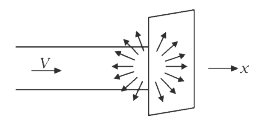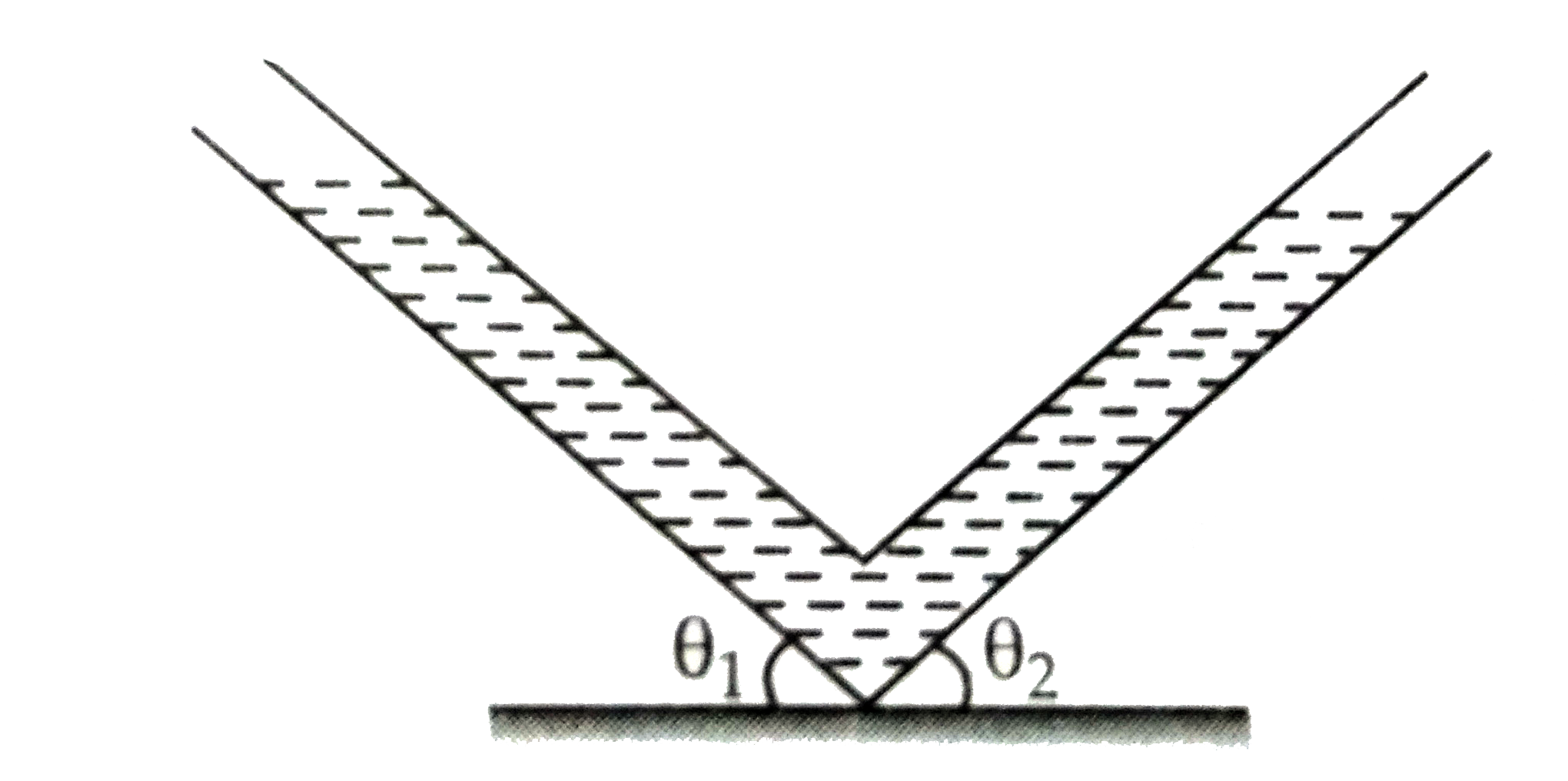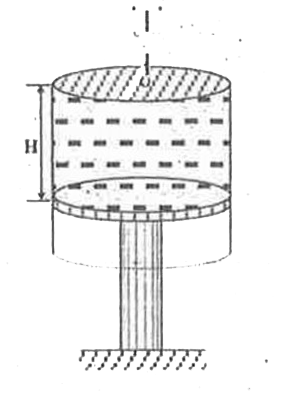A pump is used to pump a liquid of density ρ continuously through a pipe of cross, sectional area A. If liquid is flowing with speed v, then average power of pump is
13ρAV2
12ρAV2
2ρAV2
12ρAV3
The correct Answer is:D
To find the average power of the pump that is used to pump a liquid of density ρ through a pipe of cross-sectional area A at a speed v, we can follow these steps:
Step 1: Understand the definition of power
Power is defined as the rate at which work is done or energy is transferred. In this case, we will calculate the average power of the pump based on the energy required to move the liquid.
Step 2: Calculate the kinetic energy of the liquid
The kinetic energy (KE) of the liquid flowing through the pipe can be expressed as:
KE=12mv2
where m is the mass of the liquid and v is its speed.
Step 3: Relate mass to density and volume
The mass m of the liquid can be expressed in terms of its density ρ and volume V:
m=ρV
where V is the volume of the liquid flowing through the pipe.
Step 4: Determine the volume flow rate
The volume flow rate Q can be defined as:
Q=Av
where A is the cross-sectional area of the pipe. This means that the volume of liquid flowing in a time t is:
V=Q⋅t=Avt
Step 5: Substitute the volume into the kinetic energy formula
Now, substituting the expression for volume V into the kinetic energy formula:
KE=12(ρAvt)v2=12ρAv3t
Step 6: Calculate the average power
The average power P is the energy per unit time. Therefore, we can express the average power as:
P=KEt=12ρAv3tt=12ρAv3
Final Result
Thus, the average power of the pump is:
P=12ρAv3
Power is defined as the rate at which work is done or energy is transferred. In this case, we will calculate the average power of the pump based on the energy required to move the liquid.
The kinetic energy (KE) of the liquid flowing through the pipe can be expressed as:
KE=12mv2
where m is the mass of the liquid and v is its speed.
The mass m of the liquid can be expressed in terms of its density ρ and volume V:
m=ρV
where V is the volume of the liquid flowing through the pipe.
The volume flow rate Q can be defined as:
Q=Av
where A is the cross-sectional area of the pipe. This means that the volume of liquid flowing in a time t is:
V=Q⋅t=Avt
Now, substituting the expression for volume V into the kinetic energy formula:
KE=12(ρAvt)v2=12ρAv3t
The average power P is the energy per unit time. Therefore, we can express the average power as:
P=KEt=12ρAv3tt=12ρAv3
Thus, the average power of the pump is:
P=12ρAv3
Topper's Solved these Questions
- BOOK - AAKASH INSTITUTE ENGLISHCHAPTER - WORK, ENERGY AND POWEREXERCISE - SECTION-B (SUBJECTIVE TYPE QUESTIONS) (ONE OPTIONS IS CORRECT)45videos
WORK, ENERGY AND POWER
- BOOK - AAKASH INSTITUTE ENGLISHCHAPTER - WORK, ENERGY AND POWEREXERCISE - SECTION-C (OBJECTIVE TYPE QUESTIONS) (MORE THAN ONE OPTIONS ARE CORRECT)16videos
WORK, ENERGY AND POWER
- BOOK - AAKASH INSTITUTE ENGLISHCHAPTER - WORK, ENERGY AND POWEREXERCISE - TRY YOURSELF95videos
WORK, ENERGY AND POWER
- BOOK - AAKASH INSTITUTE ENGLISHCHAPTER - WAVESEXERCISE - ASSIGNMENT ( SECTION-D ( Assertion - Reason Type Questions ))12videos
WAVES
Similar Questions
An engine pumps liquid of density ρ continuously through a pipe of cross-section area A. If the speed with which liquid passes through the pipe is v, then the rate at which kinetic energy is being imparted to the liquid by the pump is
View SolutionAn engine pumps a liquid of density 'd' continuously through a pipe of area of cross-section A. If the speed with which the liquid passes through a pipe is v, then force exerted on liquid.
View SolutionA liquid of density ρ is flowing with a speed v through a pipe of cross sectional area A. The pipe is bent in the shape of a right angles as shown. What force should be exerted on the pipe at the corner to keep it fixed?
 View Solution
View SolutionA liquid of density ρ is flowing with a speed V through a pipe of cross sectional area A. What force does the liquid stream exert on wall in x direction if it splashes in the form of a circle after it hits the wall?
 View Solution
View SolutionReynolds number for a liquid of density ρ, viscosity η and flowing through a pipe of diameter D, is given by
View SolutionA non viscous liquid of density ρ is filled in a tube with A as the area of cross section, as shown in the figure. If the liquid is slightly depressed in one of the arms, the liquid column oscillates with a frequency
 View Solution
View SolutionAn incompressible liquid of density ρ is enclosed with two frictionless pistons one of cross-sectional area A and the other of 4 A. When the narrow piston moves out by a distance.
View SolutionIn the adjacent figure a cylindrical vessel of mass M and cross - sectional area A is placed inverted on a fixed smooth piston of same cross - sectional area fixed to the ground . The space between the cylinder and priston is completely filled with liquid of density ρ . There is a small office of cross - sectional area a (a<<A) at the top top portion of this vessel . ( intially length of the liquid column in the vessel is H )
Speed of the liquid with which it comes out of the vessel is
 View Solution
View SolutionIn the adjacent figure a cylindrical vessel of mass M and cross - sectional area A is placed inverted on a fixed smooth piston of same cross - sectional area fixed to the ground . The space between the cylinder and priston is completely filled with liquid of density ρ . There is a small office of cross - sectional area a (a<<A) at the top top portion of this vessel . ( intially length of the liquid column in the vessel is H ).Find the speed of the vessel with which it move
 View Solution
View SolutionA viscous liquid flows through a horizontal pipe of varying cross-sectional area. Identify the option which correctly represents the variation of height of rise of liquid in each vertical tube
View Solution

